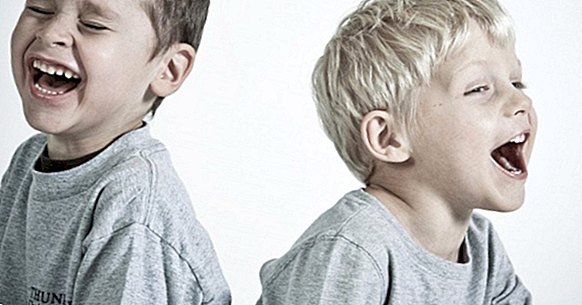How to educate in positive: 15 examples and practical strategies
The objective of this article is to offer guidelines that promote positive education , involving parents, teachers and any professional who works with children, providing an education based on the establishment of standards, clarification of boundaries, affection, preserving the rights of children and adults.
I will divide it into 3 blocks: how to favor appropriate behaviors, how to reduce inappropriate behaviors and how to help you be a positive child.
- Related article: "Positive discipline: educating from mutual respect"
How to reinforce appropriate or pro-social behaviors
Is about select the desired or appropriate behaviors to be performed by the minor (example: start doing homework at a certain time, brush your teeth, take care of your brother, leave your clothes in the basket ...). For this we use two techniques:
1. Positive reinforcement
They are compliments while performing appropriate behavior, social, verbal or playful prizes for doing something suitable. For example: if you are quietly on the couch watching TV with your little sister, say "I love that you behave like that, you are a champion", while we give a touch on the shoulder.
These reinforcements must be done immediately, while you are doing it. We must use it both with behaviors that we consider correct and that the child performs (to favor the fact that he continues to do so), and with new behaviors that do not exist in his behavioral repertoire. This will favor the increase in the frequency of an already existing behavior although at a low rate.
- Related article: "Operant conditioning: concepts and main techniques"
2. Points program
It consists of selecting the behaviors that we want to increase (doing homework, writing down the agenda, going out with friends, brushing teeth ...). Once selected we will choose a reinforcer for each of them . The ideal is to spend time with pleasant activities (watching TV, computer, eating something you like, playing with the child to something we know you love ...).
At first there must be immediacy between the performance of the desired behavior and the award . For this we can make a table that is a schedule of tasks. In the rows we would indicate the conducts to perform, in the columns the days.
Every time you do one of these behaviors you must put a point (can be with a sticker, make a cross, color it ...), if you do not, that box remains blank (avoid sad faces, negative points, red ...).
If you forget any of the tasks, you can remind them: "There is something you could do to get another point and you have forgotten, look at the schedule what it is". In case of older children, instead of using a table, we could write it as a contract, with the conduct to be performed and the corresponding bonus clause (prize) and sanction clause.
My advice is that if the child does the homework he receives the prize and if he does not the sanction is the deprivation of said prize . For example: "if you do your homework you will have free time to play; if you do not do it you will not have it "," if you eat in 30 minutes you will have the dessert that you like the most; If you do not eat in 30 minutes there will be no dessert. "
- Related article: "Token economy: how is it used to motivate changes?"
How to reduce the frequency of inappropriate behavior?
Below you can find strategies that try to minimize or reduce all disruptive or dysfunctional behavior.
1. Extinction
Consists in "Ignore" the inappropriate behavior of the child (tantrum, anger, threats, insults). Saying "do not do it anymore", "be quiet", "I'm going to get angry" ... is a way of paying attention to him, so he will continue to do so.
We must withdraw the reinforcing consequence (attention) to the emission of inappropriate behavior, so that the child learns the association between doing something inappropriate - not paying attention to it. We must ignore this type of verbalizations and behaviors not yielding to them at any time .
2. Time Out
It consists of removing the child physically from the current space to move it to your room or another place , for a short time. It can also be the parents who leave the place where the child is in the case of being unviable what I said above.
It will be done immediately to dysfunctional behavior , so that the child associates him directly with this action, with a neutral attitude, using a tone of voice as objective as possible, avoiding any attitude of anger, without scolding or shouting.
We will do it without establishing social interaction with him. In the case that the child asks why we do that to him, we will give him a concrete explanation, and without emotional charge, of the motive . We can remove the child from the reinforcing situation (for example, instigate him to go to his room and leave the room where he is hitting his brother), or eliminate the stimulus that causes the bad behavior (for example if the child begins to throw with a spoon the food you do not want to eat, remove the spoon).
The application time will be approximately 5 minutes, it will never exceed 10 , and always with supervision. The child may return to the place where he was, or we return to the site where the conflict occurred when his behavior at the last minute was adequate, trying not to do so while displaying inappropriate behavior such as screams, threats, blows ...
- Related article: "Time out: what is this behavior modification technique?
3. Overcorrection
The boy "Replenish" the damage caused . You must practice the correct way to perform the task or what you are asked to do. This technique is used for behaviors that cause damage or cause deterioration (for example: intentionally spilling milk on the table).
In these cases we must encourage the child to undo or repair the damage through positive behaviors (in this case picking up spilled milk with a rag). This may not be easy, but it is essential that the child assumes his responsibility , recognizing what you have done, solving it as soon as possible.
If the child is reluctant to practice, you must help him perform the correct actions with his hands (if he does not want to pick up, take his hands and guide them as if they were those of a robot, picking them up and depositing them in the right place).
Crying, tantrums or resistance should be ignored , tried to keep calm but firm until the task is over or the child begins to do it alone. Let's not forget, once the task is finished, praise and reinforce obedience.
- Maybe you're interested: "How to improve family communication? 4 keys"
How to make the child positive?
How to tell a child to do something? The instructions must be brief, clear and specific . Give orders one by one, using positive phrases, "do" (for example: "throw the garbage before playing the Wii", instead of "you have not thrown the garbage yet, right?").
They are recommended "Yes-then" positive sentences . For example: "if you do your homework you can go out on the street", "if you pick up your room you can watch TV". If possible, we will give you options so that you can choose (for example: if you have to take a shower, you can choose whether to do it before or after studying, as long as it complies).
We have to praise his obedience and, as we see throughout the article, establish consequences for it. It is useful to give useful reminders and reminders (for example: "when the news song sounds, you know you have to go to bed"). Parents, teachers or adults who surround the child must agree among us, avoiding unnecessary or contradictory orders, without threatening the child (for example, an incorrect way would be: "Pablo, when are you going to throw away the garbage?", "If you do not behave well, I'll have to punish you", "is it so difficult to order your room?" ...)
Using the guidelines seen above, we could say something like: "Pablo, go and throw the garbage before playing the Wii", "if you play with your sister without making her cry, I will take you to the park of the swings", "if you order your room you can take the tablet "). Let's practice the "where I said cost I say prize" (For example: instead of "if you forget to brush your teeth I will forget to give you sweets", we will say "if you brush your teeth after eating, you can eat sweets this afternoon").
- You may be interested: "Are negative emotions as bad as they seem?"
How to help you think positive
Negative thoughts ("It's going to hurt me") produce a negative view of the child ("I am bad"). For this reason we should try to avoid generalizations ("this time it has not gone as well as yesterday" instead of "it has gone wrong").
When we generalize (we use the whole, never, never, always ...), we create a label. The distortion of thought is an inadequate way of thinking that generates children a distorted view of those who are preventing them from seeing reality, negatively affecting your mood and in an unruly behavior.
One way to help is offer you an alternative instead of judging (for example: If you make a mistake in a game, we could say "look if you do it like that, it will work out better", instead of saying "you did it wrong", and not giving it a chance to improve).
How to tell what we feel bad
it implies emit a positive expression before and after a negative expression , a complaint, rejection or a request. With this, we soften the negative expression, and increase the likelihood that the recipient will hear the negative message clearly and with less discomfort.
Example: a student has done a job that is below his usual performance, and you would not want his pace to drop. According to this technique we could say something like: "the truth is that I am very happy with all your work, although I think that something has gone loose, but I am sure that the next one will be in line with the rest of the works of the whole course!
Children need to feel loved , and also need to have limits in order to internalize and establish standards preventing the breach and future sanctions of these. Helping them to have a good image of themselves will be a source of positive emotions and actions according to their objectives, so we must avoid negative labels, specifying what could have done wrong "this time" instead of "always" or " never ", providing an alternative or possible solution, always reinforcing what you do well.



















